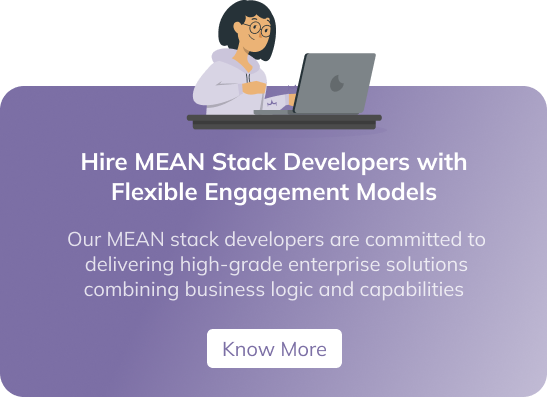
It is no more shocking that we have already entered the technological era, and custom application development has become an imperative part of it. Irrespective of which app you will develop, you will need a software stack that helps you integrate modern features and deliver a seamless user experience. In order to create a robust backend, developers need an advanced toolset, which can help them to build an mean stack development application within a timeline and streamline the resources.
With the increasing importance of mobile apps in people’s lives, it has become a compulsion for enterprises to come up with unique app features, and for that, they need a software stack that simplifies the process and fulfills the growing needs of users. Developers can choose from a plethora of different solutions, including PHP, Ruby on Rails, LAMP, Django, and many more.
Web applications in today’s businesses are meeting the changing needs of modern organizations. However, choosing the right technology stack is always a challenge, regardless of whether you are an IT leader or an entrepreneur. Consequently, it can significantly impact your development initiative’s future.
The digital era enables enterprises to build scalable web and mobile applications optimized for deployment in the cloud. Among these frameworks is the MEAN stack, which makes application development seamless and effective. Angular, MongoDB, Express, and Node are just a few of the advanced technologies included in the MEAN stack – ideal for developing innovative applications.
In addition to YouTube, Facebook, Netflix, Tumblr, Forbes, Instagram, and many more, MEAN stack JavaScript has been used by renowned brands to build applications. The MEAN stack is a great example of this approach. Learn what it is, why it’s worth learning, and why it might be the right solution for you.
Understanding the Components of MEAN Stack
MongoDB, Express.js, Angular.js, and Node.js are the four user-friendly technologies combined to form a full-stack JavaScript framework referred to as MEAN. A cloud-ready app or website can be built with these frameworks because they are free and open-source. In addition, these frameworks’ free and open-source nature allows rapid prototyping for various applications. Most of the time, these are web-based applications.
In Stack, MEAN stands for MongoDB, Express, Angular, and Node, the four main technologies.
- MongoDB – document database
- Express.js – Node.js web framework
- Angular.js – a client-based JavaScript framework
- Node.js – the premium JavaScript web server
MEAN stack development models are among the most popular technologies for developing web and mobile applications. Indeed, every app’s mobile architecture is different, but it is incredibly easy to build web applications using JavaScript and handle JSON with the MEAN architecture.
In addition to its simplicity, JavaScript runs across every code line of the MEAN stack, which is one of its best features. Aside from convenience, that’s an excellent deal for web and app developers to build their projects more efficiently and effectively.
Statista found that 17.9% of respondents ranked MongoDB among the most wanted skills among database professionals. It ranked second globally to PostgreSQL, which gained less than 18%. The MEAN stack frameworks are used together to create modern web applications. Now the question is why to use different frameworks and tools.
Imagine you want to build a website. If we use only one language or framework, the website or application will be limited in terms of features and functionalities. While using several tools and frameworks, we can get scalability and flexibility and thus can survive in the competition. Each toolset comes with its own specialty.
JavaScript can easily handle the logic, while MongoDB can handle the data. In addition, a PHP framework called Laravel and a NoSQL database called Redis is added. These two technologies give us almost limitless opportunities to develop new applications!
In other words, if you want to understand how modern web apps are created and maintained, you need to become familiar with some or all of these technologies. Moreover, hiring MEAN stack developers for your project is equally significant as you can leverage their expertise and ask them to employ modern best web practices.
What Benefits Does MEAN Stack Development Offer?
MEAN apps can be used in a variety of ways thanks to a cross-platform start writing style. MEAN can be used in a variety of situations, but it works best in real-time applications. For example:
- Tools for managing workflow
- News websites
- Applications such as to-do lists and calendars
- Interactive forums
The components of the Stack are easy to integrate because they are all based on JavaScript and JSON. Although MEAN Stack is a young technology, organizations and developers have seen its potential. Consequently, these are the main benefits of using MEAN Stack while creating web applications.
Low Development Cost
A free-to-use set of features make up the open-source, full-stack JavaScript framework known as MEAN. As a result, using this framework results in lower costs and expenses across the entire development process for any project. Additionally, JavaScript helps developers by providing code-sharing features that instantly reduce the overall development time and expense.
JavaScript Object Notation
JSON, also known as JavaScript Object Notation, is a good format for storing and sending data. JSON is used by both AngularJS and NodeJS components of the MEAN stack. Even MongoDB stores data in the JSON Format. This helps MEAN Stack and enterprises when creating web applications. The data does not need to be restructured, yet it is essential to support bigger initiatives.
One Stack, One Programming Language
Each framework that makes up the MEAN stack uses one programming language, namely Javascript. However, the majority of the alternative stacks make use of several frameworks, necessitating the developer’s knowledge of numerous languages. For example, just to get started with full-stack web development, you might need to master languages like PHP, Ruby, and Python, in addition to others. But all you need to learn for the MEAN stack is Javascript.
Offers Top-notch Flexibility
MEAN Stack is ideal for enterprises requiring particular functionality in their applications because it enables you to construct apps with various features and functions. Additionally, incredibly adaptable, MEAN Stack enables developers to modify the platform as required. As a result, businesses may easily build creative products without having to worry about technical constraints because of MEAN Stack’s versatility.
Code Reusability and Cloud-friendly
The MEAN stack makes it possible to create user interfaces that are friendly to use. It supports the Model-View-Controller (MVC) architecture to create online apps that seem native. To increase the speed of websites, it removes the overload of request processing and leverages Node.js for non-blocking type I/O. Additionally, it uses Angular to increase code reuse.
Utilizing cloud repositories, this technology stack makes use of open-source frameworks. Even MongoDB offers support when using the cloud.
Sound Prototyping Abilities
Every company wants to create a prototype to test the functionality and user requirements. Because of this, businesses choose to create an MVP. The Minimum Viable Product method for prototyping is not just practical but also economical. It enables organizations to assess the viability and usability of their application idea or concept. One of the greatest tools for businesses to develop MVP processes is the MEAN stack.
Worldwide Community Support
A ubiquitous programming language is JavaScript. Consequently, communities are emerging worldwide that offer ongoing assistance from experts and leaders. MEAN Stack provides modern functionalities for web development applications. Traditional web apps, for instance, would necessitate page refreshing.
Single-page applications are frequently used by MEAN Stack, minimizing the need to refresh web pages. This increases its popularity among companies and developers.
Famous Brands Using MEAN Stack Development
The majority of large businesses employ MEAN Stack Development to design frontend and backend and produce potent online applications. In addition, we have discovered a large number of international businesses using MEAN Tech Stack to create their web apps.
- Netflix
- Uber
- Trello
- NASA
- eBay
Apart from these companies, Forbes first spent two months developing a unique CMS on MongoDB. Within a month, Forbes also unveiled a mobile website. Only one full-time developer and one part-time developer were required to complete all of this. Despite the small crew size, the outcomes were enormous.
The MEAN component cut down on both time and expense by assisting JAVA developers in learning MongoDB’s structure. In addition, over 1000 bloggers worldwide can now submit pieces to Forbes, which uses the CMS platform to create material.
The traffic of Forbes.com surged from 5% to 15% and then soared to 50%. Now, thanks to MongoDB, Forbes enables the quick upload of valuable articles.
Wrapping It Up
The MEAN stack has many benefits for companies trying to create web apps. The MEAN stack is an appealing choice for business app development because of NodeJS’s scalability and speed, MongoDB’s adaptability, ExpressJS’s simplicity, AngularJS’s potent capabilities, and the plethora of NodeJS modules accessible.
If you are looking to build web and mobile apps using the MEAN stack, hire MEAN stack developers who have professional skills with prominent experience in this domain.










